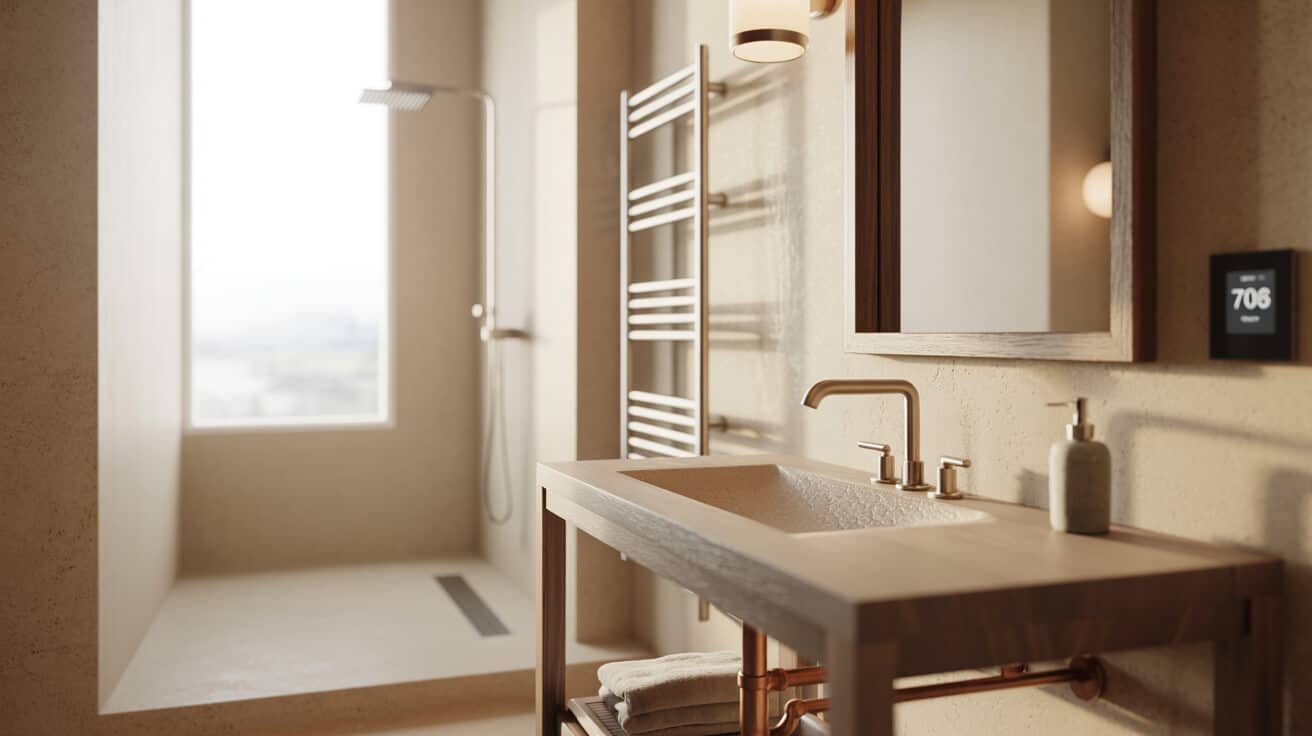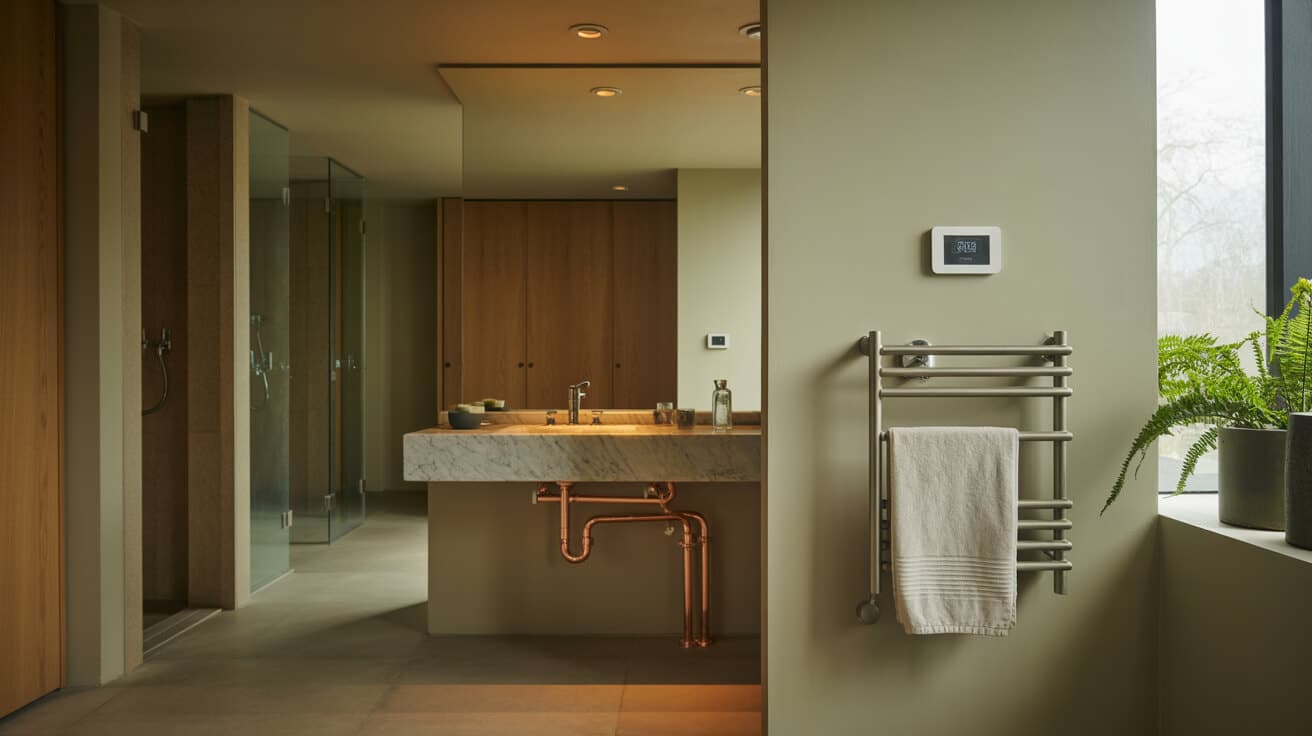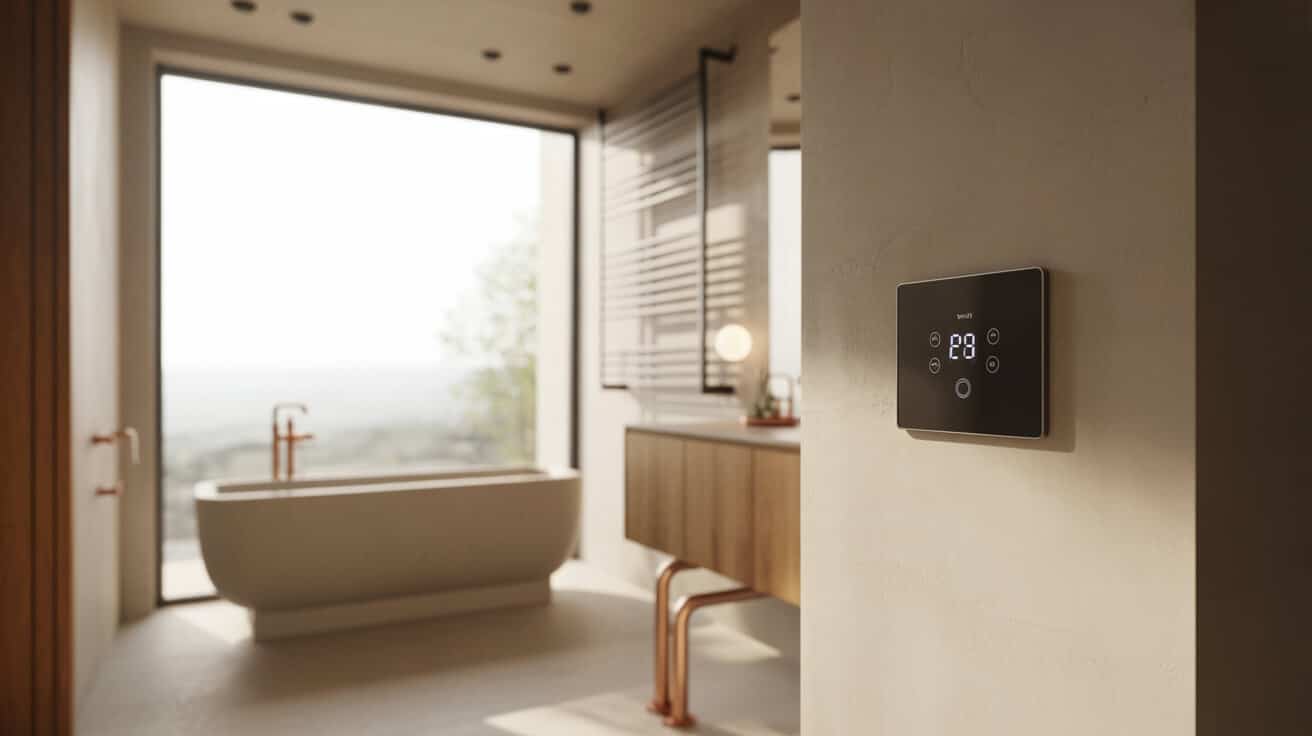Lead
The emergence of weather compensation heating marks a significant progression from legacy, time-based thermostatic controls toward intelligent modulation anchored to actual building heat loss. Systems operating on this principle automatically regulate the temperature of boilers, heat pumps, or manifold circuits, adjusting flow according to outdoor climate readings rather than static indoor thresholds. Plumbing and heating providers—including Plumbers 4U—design and commission these systems to satisfy stringent regulatory requirements and to help property owners, landlords, and facilities directors realise the dual goals of fuel cost reduction and steady internal comfort for occupants. The methodology is equally pertinent to new builds, energy retrofits, and management of rental and portfolio properties, establishing a new baseline for building services engineering and property asset optimization.
Etymology or name origin
The phrase “weather compensation” directly refers to compensating for external weather variations in the control of building heat output. Alternate terminologies, such as “outdoor reset,” “external temperature compensation,” and “climate-adaptive modulation,” appear throughout technical documents, regulatory codes, and product literature. These terms have been popularised in global technical standards and reflect both advances in sensor technology and efforts to clarify operational intent for users and system designers.
Overview / context
Weather compensation heating reflects a foundational shift in system control logic, responding dynamically to seasonal and diurnal outdoor temperature changes that drive building heat loss. Unlike traditional approaches that rely on preset or manual room thermostat activation, weather-compensated methods aim to anticipate heating demand, preempt cold snaps, and adjust output in real time for highest efficiency. Such systems are especially valuable for buildings with variable occupancy, mixed-use properties, and managed estates where consistency and cost control are paramount.
Principles of operation
At the core of every weather compensation system is an external temperature sensor. Data from this sensor streams continuously to a controller—whether standalone or embedded in boiler logic—where the system references a predefined “heating curve.” The curve maps external temperatures to required supply temperatures for heat emitters, ensuring your property receives only the energy necessary to maintain stable interiors. Modulation is continuous: as the weather warms, system output is reduced, resulting in less fuel consumed, while cold spells automatically cue increased supply, all without disruptive manual intervention.
Role in building services
Building services professionals specify, instal, and maintain weather compensation controls as a lever for energy savings and legal compliance. The approach is foundational to sustainability-centric system design and is recognised as a qualifying feature for a wide spectrum of national and local incentive programmes. Retrofit applications commonly target landlord portfolios and communal housing, where compliance and comfort are dual priorities.
Sector adoption patterns
Adoption aligns closely with energy policy evolution and the rollout of enhanced Minimum Energy Efficiency Standards (MEES). Usage is strongest where fuel costs impact operational budgets and where regulatory compliance drives investment—ranging from landlords and letting agents seeking standardised tenant comfort, to commercial operators balancing overheads and user satisfaction, to homeowners pursuing a smarter, more resilient heating architecture.
Terminology variations
Industry alternate names mirror underlying technical diversity as well as region-and-brand specific history. End-users and professionals may encounter “climate-adaptive modulation” in product literature, “outdoor reset” in continental standards, or “automatic curve regulation” in regulatory guidelines; all refer to the core weather-responsive control methodology.

History
Origins
The earliest weather-responsive heating controls emerged in mid-20th-century European and North American commercial properties, where facilities managers deployed mechanical thermostats with expansion bellows, connecting outdoor temperature probes to mixing valves across large heating circuits. These systems provided only basic compensation, lacking the fine-tuned calibration of digital controls.
Industrial emergence
Widespread adoption began in the latter half of the 20th century with the introduction of electronic sensors and programmable logic controllers. Large social housing estates, offices, and public buildings drove demand for automated modulation, especially in regions where heating demand fluctuates rapidly. In the UK, local authority policy and the drive towards environmental benchmarks supported migration from rudimentary thermostats to precision-controlled weather compensation modules.
Manufacturers responded by developing proprietary controllers for boilers, central plant, and manifold systems. The regulatory scaffold grew with the inclusion of adaptive control features in Building Regulations Part L and the proliferation of energy labelling schemes.
Contemporary evolution
Recent decades brought the democratisation and sophistication of weather compensation heating. Microprocessors, digital sensors, and modular app algorithms now support fine grain adjustment, enabling your company to deliver weather compensation controls in newly constructed smart homes, estate retrofits, and complex multi-zone commercial properties. Plumbers 4U leverages these advances to provide systems harmonised with the requirements of modern, energy-focused clients, integrating heating curve logic, multi-sensor architectures, and dynamic learning layers to serve both comfort and compliance.
Concept / description
Control logic and feedback mechanisms
Weather compensation heating functions as a closed-loop, anticipatory system combining three key hardware and software elements: an outdoor sensor, a programmable controller, and one or more actuators (such as boiler modulation interfaces, pump speed controls, or motorised valves).
- Outdoor sensors: measure ambient external temperature, often installed on the north or shaded facade to limit bias from solar gain.
- Programmable controllers: house the heating curve logic, adjusting the system’s supply temperature in response to the evolving weather data.
- Actuators: execute state changes, shifting flow temperatures or diverting energy as required. In advanced systems, these actuators operate independently per zone, based on zone-specific curves or schedules.
The system’s heating curve, a line or function relating outside temperature to optimal circuit flow temperature, is configured at commissioning and recalibrated seasonally or in response to changes in property insulation or usage.
Heating curves and system calibration
Calibration involves choosing the slope and shape of the heating curve. A steeper slope delivers higher temperatures for a given drop in external conditions, suiting older or draughtier properties; a shallow curve is optimal for well-insulated, low-loss modern buildings. Proper calibration ensures your property receives efficient, comfortable warmth with minimum energy input. Advanced controllers enable dynamic curve adjustment, further automating and optimising outcomes without manual intervention.
Component overview: sensors, modules, protocols
Weather compensation configurations differ, but generally include:
- Weatherproof digital thermistor sensors
- Controllers incorporating heating curve programming, zone control, and override features
- Communication protocols, such as OpenTherm, eBUS, or brand-specific digital buses for controller–boiler communication
- Actuators including modulating valves and variable-speed system pumps
Designs may integrate supplementary indoor sensors for further fine-tuning or multi-zone adjustment.
Smart and connected variants
Many systems support app-based scheduling, remote parameter changes, historical analysis, and integration with building energy management platforms. Data flow offers analytic depth for facilities managers or property owners to benchmark consumption, optimise usage, and evidence compliance or grant eligibility.
Functionality / purpose / applications
Practical use and benefits
Weather compensation maximises comfort by providing continuous, granular adjustment to interior temperature through direct modulation of system supply based on real-world weather. The approach:
- Delivers energy savings, especially for Condensing Boilers or high-mass systems
- Promotes internal comfort with minimal manual adjustment
- Enhances regulatory compliance across owner-occupied, rental, and commercial properties
- Prolongs system lifespan by reducing plant cycling and high-temperature operation
Areas of deployment
Single-family homes
In domestic properties, this method supports ease of use and stable comfort, with added value in energy cost reductions—especially for increasingly thermally efficient modern homes or advanced retrofits.
Landlord and portfolio properties
Portfolio managers and professional landlords specify weather compensation to raise efficiency, bolster tenant satisfaction scores, and align with legal requirements. Such systems reduce maintenance callouts and headaches linked to inconsistent system performance, while ensuring standardised conditions and evidence of MEES and other regulatory compliance.
Commercial and managed estates
Large buildings—offices, healthcare, retail, blocks—use centralised and zonal weather compensation as part of multi-level energy management, driving operational cost down and improving comfort. Facility managers gain granular control and diagnostic visibility, which are critical for asset protection and staff productivity.
District and networked heating
Weather compensation underpins supply-side temperature modulation in district heating and communal systems, harmonising demand across varied client circuits and offering equitable comfort outcomes in multi-user arrangements.
System integration with smart control
Smart controllers enable integration with occupancy sensors, scheduling routines, or property management interfaces. Multi-zone logic allows for coordinated cross-zone compensation—supporting different curves for communal spaces versus specialist rooms or extensions.
Intended outcomes
- Direct, measurable reductions in energy consumption and bills
- Improved compliance and regulatory standing for owners and landlords
- Simplified property management, with decreased troubleshooting and service events
- Higher satisfaction for tenants, guests, or residents
Classifications / types / variants
- Integrated controllers: Factory-installed with boilers or heat pumps, and tightly coupled to manufacturer-specific logic.
- Third-party/aftermarket kits: Designed for compatibility across systems, enabling retrofitting or system upgrades.
- Manual vs automated controllers: Some offer granular on-site adjustments; others use adaptive, self-learning algorithms to refine performance dynamically.
- Single-zone and multi-zone: From whole-building controls to per-area, per-room, or per-tenant regulation.
- Emitter-specific systems: Optimised for radiators, underfloor, or multi-emitter systems, with variable strategy and control architecture.

Systems / tools / methodologies
Sensor kits and controller technology
Weather compensation system design starts by selecting robust, manufacturer-compatible weatherproof sensors. Controllers—whether wall-based digital units or smart-home integrated touchscreens—are set up with appropriate firmware, curve libraries, and override logging features.
Programming and commissioning
Upon installation, the system is programmed via:
- Pairing all sensors and actuators
- Inputting or selecting the most appropriate heating curve for your property’s thermal inertia, occupancy, and location
- Testing system modulation through simulated weather input or real-day step changes
- User training for override and feedback features
Actuators and component integration
Valve and pump actuation is optimised for property-specific delivery—zonal pumps for blocks or commercial estates, mixing valves for UFH, and direct modulation for condensing boilers and hybrid heat pumps.
Retrofit vs new build
Retrofits often require careful sensor route planning, communicating with legacy wiring, and professional system survey. New builds are designed from the outset for weather compensation, with integrated cable runs, optimised module selection, and firmware updates part of the build process.
Stakeholders / entities involved
- Heating and plumbing engineers: – Instal, commission, and maintain systems for long-run reliability
- Property owners, landlords, and portfolio managers: – Specify systems to balance compliance, cost, and occupant experience
- Facilities managers, letting agents, and building supervisors: – Ensure daily performance and energy benchmarks are met
- Manufacturers and component suppliers: – Design, test, and innovate controls and sensors
- Regulatory and standardisation bodies: – Define and update technical standards and compliance pathways
Legal / regulatory / ethical considerations
Building and housing regulations
Building Regulations Part L and Boiler Plus—mandatory in markets such as the UK—require advanced controls for most new and replacement heating system installations. Weather compensation heating meets or exceeds these requirements, qualifying property owners for certain grants, incentives, and regulatory privileges.
Landlord and portfolio compliance
Landlords must supply effective heating solutions that comply with energy-efficiency and tenant comfort statutes, particularly under evolving MEES, EPC, and local comfort regulations. Weather compensation heating provides a documented pathway to minimum statutory standards, supporting both audit evidence and grant or rebate applications.
Data privacy and user rights
Wherein your property is equipped with systems allowing remote or app-based monitoring, compliance with privacy standards and data handling legislation (such as GDPR in the UK/EU) is necessary. Your organisation should provide clear system use instructions and explanations of any data use or rights for tenants and residents.
Performance metrics / data / measurements
| Metric | Typical Range | Value to Audience |
|---|---|---|
| Energy consumption reduction | 5%–20% | Lower heating bills; improved ROI |
| EPC rating improvement | 1–2 bands (with upgrades) | Regulatory compliance, higher asset value |
| Boiler runtime (condensing) | Increased | Higher system longevity |
| Comfort deviation (°C) | <1°C (well-calibrated) | Elevated tenant satisfaction |
| Service call rate | Decrease post-instal | Operational cost and time savings |
Additional measurements include weather response latency, manual override frequency, and the granularity of multi-zone output, all tied to your organisation’s energy strategy, comfort targets, and regulatory mandates.
Challenges / barriers / limitations
Operational or technical issues
- Technical incompatibility between controller and boiler/model
- Calibration errors during setup, leading to inefficiency or user discomfort
- Sensor placement difficulties, especially in existing building stock
- System failures or faults with legacy wiring
- Complexity of multi-zone or hybrid emitter setups
Social or economic factors
- Investment costs, particularly in retrofit scenarios or with advanced feature sets
- Requirement for skilled engineer commissioning; steep learning curve for untrained operators
- Resistance or confusion among end-users, particularly where interface is unclear or insufficient training delivered
Philosophical or political objections
- Policy debates on over-regulation in sectors with low heating consumption
- Concerns over user autonomy versus automated, “black box” plant operations
- Equity of access for lower-income or vulnerable housing stock
Impact / influence / legacy
Weather compensation heating has redefined service standards in plumbing and property management. The approach catalysed shifts toward performance-based engineering, displacing one-size-fits-all scheduling and enabling customised, tenant- or client-centric internal environments. Policy frameworks increasingly build around adaptive control, expanding grant and subsidy opportunities and solidifying weather compensation’s position as a key tool in asset upgrade and compliance strategy. Companies such as Plumbers 4U have led in adopting and advocating effective, user-informed system designs—demonstrating the link between advanced controls, elevated building value, and enduring client satisfaction.
Future directions, cultural relevance, and design discourse
The sector’s evolution is shaping toward even more integrated, self-learning heating solutions, with growing focus on harmonious synergy between property architecture, occupant habits, and real-time energy tariffs. Weather compensation control is expected to evolve via:
- Modular system upgrades using AI-driven curve adaptation
- Deeper mesh integration with building management and grid response
- Cultural normalisation of adaptive automation as comfort expectation rather than luxury
- Policy recalibration for net-zero ambitions and social housing modernization
- New service models that position your organisation not just as installer, but as continuing partner in energy and well-being optimization
As these trends accelerate, weather compensation heating is positioned at the intersection of technology, policy, and user experience, serving as both a technical solution to environmental and operational challenges and a cultural emblem of modern property stewardship.

